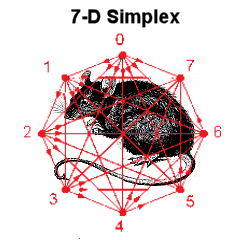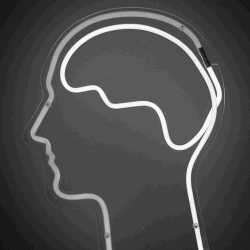 An interesting but somewhat problematic paper from the Blue Brain project claims that the application of topology to neural models has provided a missing link between structure and function. That’s exciting because that kind of missing link is just what we need to enable us to understand how the brain works. The claim about the link is right there in the title, but unfortunately so far as I can see the paper itself really only attempts something more modest. It only seems to offer a new exploration of some ground where future research might conceivably put one end of the missing link. There also seem to me to be some problems in the way we’re expected to interpret some of the findings reported.
An interesting but somewhat problematic paper from the Blue Brain project claims that the application of topology to neural models has provided a missing link between structure and function. That’s exciting because that kind of missing link is just what we need to enable us to understand how the brain works. The claim about the link is right there in the title, but unfortunately so far as I can see the paper itself really only attempts something more modest. It only seems to offer a new exploration of some ground where future research might conceivably put one end of the missing link. There also seem to me to be some problems in the way we’re expected to interpret some of the findings reported.
That may sound pretty negative. I should perhaps declare in advance that I know little neurology and less topology, so my opinion is not worth much. I also have form as a Blue Brain sceptic, so you can argue that I bring some stored-up negativity to anything associated with it. I’ve argued in the past that the basic goal of the project, of simulating a complete human brain is misconceived and wildly over-ambitious; not just a waste of money but possibly also a distraction which might suck resources and talent away from more promising avenues.
One of the best replies to that kind of scepticism is to say, well look; even if we don’t deliver the full brain simulation, the attempt will energise and focus our research in a way which will yield new and improved understanding. We’ll get a lot of good research out of it even if the goal turns out to be unattainable. The current paper, which demonstrates new mathematical techniques, might well be a good example of that kind of incidental pay off. There’s a nice explanation of the paper here, with links to some other coverage, though I think the original text is pretty well written and accessible.
As I understand it, topological approaches to neurology in the past have typically considered neural networks as static objects. The new approach taken here adds the notion of directionality, as though each connection were a one-way street. This is more realistic for neurons. We can have groups of neurons where all are connected to all, but only one neuron provides a way into the group and one provides a way out; these are directed simplices. These simplices can be connected to others at their edges where, say, two of the member neurons are also members of a neighbouring simplex. Where there are a series of connected simplices, they may surround a void where nothing is going on. These cavities provide a higher level of structure, but I confess I’m not altogether clear as to why they are interesting. Holes, of course, are dear to the heart of any topologist, but in terms of function I’m not really clear about their relevance.
Anyway, there’s a lot in the paper but two things seem especially noteworthy. First, the researchers observed many more simplices, of much higher dimensionality, than could be expected from a random structure (they tested several such random structures put together according to different principles). ‘Dimensionality’ here just refers to how many neurons are involved; a simplex of higher dimensionality contains more neurons. Second they observed a characteristic pattern when the network was presented with a ‘stimulus’; simplices of gradually higher and higher dimensionality would appear and then finally disperse. This is not, I take it, a matter of the neurons actually wiring up new connections on the fly, it’s simply about which are involved actively by connections that are actually firing.
That’s interesting, but all of this so far was discovered in the Blue Brain simulated neurons, more or less those same tiny crumbs of computationally simulated rat cortex that were announced a couple of years ago. It is, of course, not safe to assume that real brain behaves in the same way; if we rely entirely on the simulation we could easily be chasing our tails. We would build the simulation to match our assumptions about the brain and then use the behaviour of the simulation to validate the same assumptions. In fact the researchers very properly tried to perform similar experiments with real rat cortex. This requires recording activity in a number of adjacent neurons, which is fantastically difficult to pull off, but to their credit they had some success; in fact the paper claims they confirmed the findings from the simulation. The problem is that while the simulated cortex was showing simplices of six or seven dimensions (even higher numbers are quoted in some of the media reports, up to eleven), the real rat cortex only managed three, with one case of four. Some of the discussion around this talks as though a result of three is partial confirmation of a result of six, but of course it isn’t. Putting it brutally, the team’s own results in real cortex contradicted what they had found in the simulation. Now, there could well be good reasons for that; notably they could only work with a tiny amount of real cortex. If you’re working with a dozen neurons at a time, there’s obviously quite a low ceiling on the complexity you can expect. But the results you got are the results you got, and I don’t see that there’s a good basis here for claiming that the finding of high-order simplices is supported in real brains. In fact what we have if anything is prima facie evidence that there’s something not quite right about the simulation. The researchers actually took a further step here by producing a simulation of the actual real neurons that they tested and then re-running the tests. Curiously, the simulated versions in these cases produced fewer simplices than the real neurons. The paper interprets this as supportive of its conclusions; if the real cortex was more productive of simplices, it argues, then we might expect big slabs of real brain to have even more simplices of even higher dimensionality than the remarkable results we got with the main simulation. I don’t think that kind of extrapolation is admissible; what you really got was another result showing that your simulations do not behave like the real thing. In fact, if a simulation of only twelve neurons behaves differently from the real thing in significant respects, that surely must indicate that the simulation isn’t reproducing the real thing very well?
The researchers also looked at the celebrated roundworm C. Elegans, the only organism whose neural map (or connectome) is known in full, and apparently found evidence of high-order simplices – though I think it can only have been a potential for such simplices, since they don’t seem to have performed real or simulated experiments, merely analysing the connectome.
Putting all that aside, and supposing we accept the paper’s own interpretations, the next natural question is: so what? It’s interesting that neurons group and fire in this way, but what does that tell us about how the brain actually functions? There’s a suggestion that the pattern of moving up to higher order simplices represents processing of a sensory input, but in what way? In functional terms, we’d like the processing of a stimulus to lead on to action, or perhaps to the recording of a memory trace, but here we just seem to see some neurons get excited and then stop being excited. Looking at it in simple terms, simplices seem really bad candidates for any functional role, because in the end all they do is deliver the same output signal as a single neural connection would do. Couldn’t you look at the whole thing with a sceptical eye and say that all the researchers have found is that a persistent signal through a large group of neurons gradually finds an increasing number of parallel paths?
At the end of the paper we get some speculation that addresses this functional question directly. The suggestion is that active high-dimensional simplices might be representing features of the stimulus, while the grouping around cavities binds together different features to represent the whole thing. It is, if sketchy, a tenable speculation, but quite how this would amount to representation remains unclear. There are probably other interesting ways you might try to build mental functions on the basis of escalating simplices, and there could be more to come in that direction. For now though, it may give us interesting techniques, but I don’t think the paper really delivers on its promise of a link with function.



 The way the brain works is more complex than we thought. That’s a conclusion that several pieces of research over recent years have suggested for one reason or another: but some particularly interesting conclusions are
The way the brain works is more complex than we thought. That’s a conclusion that several pieces of research over recent years have suggested for one reason or another: but some particularly interesting conclusions are